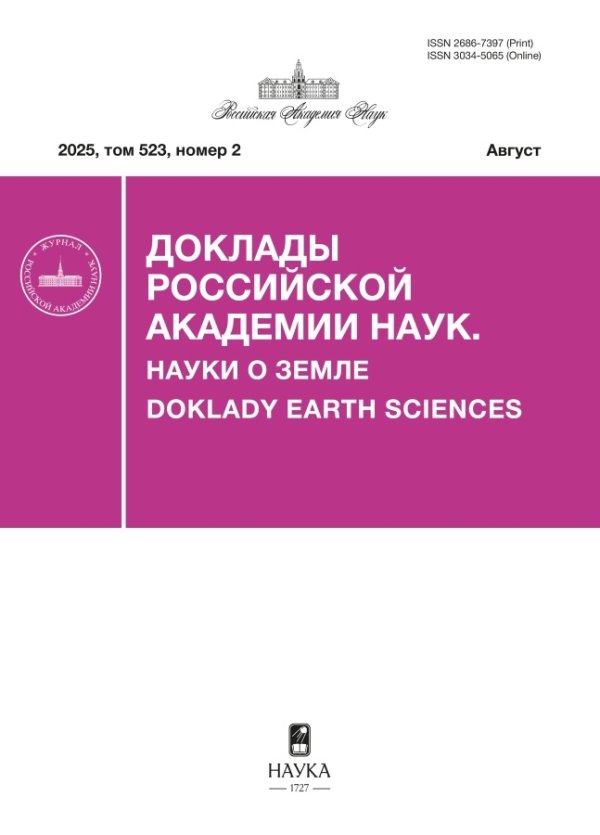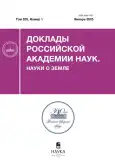Поиски природного водорода в России: состояние проблемы и возможные стартовые решения
- Авторы: Абукова Л.А.1, Волож Ю.А.2, Филиппова Д.С.1, Сафарова Е.А.1
-
Учреждения:
- Институт проблем нефти и газа Российской Академии наук
- Геологический институт Российской Академии наук
- Выпуск: Том 520, № 1 (2025)
- Страницы: 63-73
- Раздел: ГЕОЛОГИЯ НЕФТИ И ГАЗА
- Статья получена: 03.06.2025
- Статья опубликована: 30.05.2025
- URL: https://modernonco.orscience.ru/2686-7397/article/view/682406
- DOI: https://doi.org/10.31857/125020501406-8
- EDN: https://elibrary.ru/GWXNNI
- ID: 682406
Цитировать
Полный текст
Аннотация
К моменту принятия решения (приказ Росстандарта 7 июля 2023 года № 490-ст) о включении водорода в общероссийский классификатор полезных ископаемых в России исследования по геолого-экономическому анализу возможностей промышленного освоения ресурсов водорода не проводилось. Более того, ископаемый водород был изучен крайне слабо. Сложившееся положение требует ускоренной разработки поисковой водородной концепции, построенной на научном обосновании наиболее перспективных региональных направлений работ. В статье авторы излагают своё видение этой проблемы и предлагают её возможные решения. В частности, аргументируется необходимость организации научно-технологических водородных полигонов, в задачи которых будет входить: (i) развитие теоретических представлений о роли водорода в эволюции Земли; (ii) детализация механизмов локализации водорода в геологической среде; (iii) разработка критериев и методов геолого-экономической оценки поисков, разведки и добычи водорода; (iv) проведение геолого-промысловых исследований на наиболее перспективных объектах для разработки и апробации методики поиска залежей водорода и сопутствующих полезных ископаемых.
Полный текст
Об авторах
Л. А. Абукова
Институт проблем нефти и газа Российской Академии наук
Автор, ответственный за переписку.
Email: abukova@ipng.ru
Россия, Москва
Ю. А. Волож
Геологический институт Российской Академии наук
Email: abukova@ipng.ru
Россия, Москва
Д. С. Филиппова
Институт проблем нефти и газа Российской Академии наук
Email: abukova@ipng.ru
Россия, Москва
Е. А. Сафарова
Институт проблем нефти и газа Российской Академии наук
Email: abukova@ipng.ru
Россия, Москва
Список литературы
- Абукова Л. А., Волож Ю. А. Флюидодинамика глубокопогруженных зон нефтегазонакопления осадочных бассейнов // Геология и геофизика. 2021. Т. 62. № 8. С. 1069–1080. https://doi.org/10.15372/GiG2021132
- Абукова Л. А., Сафарова Е. А., Филиппова Д. С., Поднек В. Э., Кияченко Ю. Ф., Юдин И. К., Исаева Г. Ю., Мельник А. Д., Бевзо М. О. Гидрохимические и микробиологические процессы, сопровождающие гибридное хранение водорода и метана в водоносных горизонтах // Актуальные проблемы нефти и газа. 2023. № 3. https://doi.org/10.29222/ipng.2078-5712.2023-42.art14
- Исаев В. П. Термодинамические аспекты геохимии природных газов. Часть 2 // Иркутск: Издательство Иркутского университета, 1991. 192 с.
- Ларин В. Н. Гипотеза изначально гидридной Земли. М.: Недра, 1975. 100 с.
- Левшунова С. П. Водород и его биогеохимическая роль в образовании углеводородных газов в осадочных породах земной коры / Автореф. дис. … докт. геол.-мин. н. М.: МГУ, 1994. 40 с.
- Леин А. Ю., Богданов Ю. А., Сагалевич А. М. и др. Новый тип гидротермального поля на Срединно-Атлантическом хребте (поле Лост-Сити, 30 с. ш.) // Доклады РАН. Науки о Земле. 2004. Т. 394. № 3. С. 380–383.
- Трофимук А. А., Молчанов В. И., Параев В. В. Особенности геодинамических обстановок формирования гигантских месторождений нефти и газа // Геология и геофизика. 1998. Т. 39(5). № 5. С. 673–682.
- Пуха В. В., Нивин В. А., Мокрушина О. Д. Вариации концентраций молекулярного водорода в рыхлых отложениях Хибинского и Ловозерского массивов и их экзоконтактовых зон // Труды Ферсмановской научной сессии ГИ КНЦ РАН. 2022. № 19. С. 312–317. https://doi.org/10.31241/FN S.2022.19.057
- Nazina T. N., Abukova L. A., Tourova T. P., Babich T. L., Bidzhieva S. K., Loiko N. G., Filippova D. S., Safarova E. A. Biodiversity and Potential Activity of Microorganisms in Underground Gas Storage Horizons // Sustainability. 2023. No. 15. 9945. https://doi.org/10.3390/su15139945
- Онежская палеопротерозойская структура (геология, тектоника, глубинное строение и минерагения) / Отв. ред. Л. В. Глушанин, Н. В. Шаров, В. В. Щипцов. Петрозаводск: Карельский научный центр РАН, 2011. 431 с.
- Соколов В. А. Геохимия природных газов. М.: Недра, 1971. 337 с.
- Патент РФ № 2316028C2. Способ поисков в недрах земли скоплений газообразных водорода и гелия // Кудрин И. В., ООО “Веттос”, МПКG01V 11/00 (2006.01)
- Федонкин М. А. Роль водорода и металлов в становлении и эволюции метаболических систем // Проблемы зарождения и эволюции биосферы (под ред. Э. М. Галимова). М.: Книжный дом “Либроком”, 2008. С. 417–437.
- Филиппова Д. С. Водород в геологической среде: особенности генерации и аккумуляции // SOCAR Proceedings. 2023. Special Issue No. 2. С. 6–13. http://doi.org/10.5510/OGP2023SI200885
- Aimikhe V., Eyankware O. E. Recent Advances in White Hydrogen Exploration and Production: A Mini Review // J. Energy Res. Rev. 2023. V. 13. No. 4. P. 64–79. http://doi.org/10.9734/jenrr/2023/v13i4272
- Lapi T., Chatzimpiros P., Raineau A., Prinzhofer A. System approach to natural versus manufactured hydrogen: An interdisciplinary perspective on a new primary energy source // International Journal of Hydrogen Energy. 2022. No. 47(2). http://doi.org/10.1016/j.ijhydene.2022.05.039
- Parnell J., Blamey N. Global hydrogen reservoirs in basement and basins // Geochemical Transactions. 2017. Issue 18. No. 2. https://doi.org/10.1186/s12932-017-0041-4
- Prinzhofer A., Cissé C. S. T., Diallo A. B. Discovery of a large accumulation of natural hydrogen in Bourakebougou (Mali) // International Journal of Hydrogen Energy. 2018. 43(42). P. 19315–19326. http://doi.org/10.1016/j.ijhydene.2018.08.193
- Truche L., Jodin-Caumon M. C., Lerouge C. et al. Sulphide mineral reactions in clay-rich rock induced by high hydrogen pressure. Application to disturbed or natural settings up to 250◦C and 30 bar. // Chem. Geol. 2013. No. 351. Р. 217–228. http://doi.org/10.1016/j.chemgeo.2013.05.025
- Zgonnik V. The occurrence and geoscience of natural hydrogen: Acomprehensive review // Earth-Science Reviews. 2020. No. 203. P. 103–140. http://doi.org/10.1016/j.earscirev.2020.103140
Дополнительные файлы

Примечание
Представлено академиком РАН М.А. Федонкиным 19.08.2024 г.












